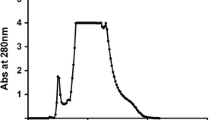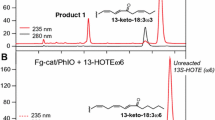Abstract
Nitrite is oxidized to nitrate by high concentrations of beef-liver catalase and byAspergillus flavus hyphal extracts. From 80 to 90 % of the nitrite-nitrogen is recovered as nitrate. The fungal enzyme is soluble and non-cytochrome-linked. It is distinct from the fungal catalase and apparently acts peroxidatively.
Hydroxylamine is metabolized by high concentrations of catalase, and about half of the hydroxylamine which disappears is recovered as nitrate. Horseradish peroxidase catalyzes the formation of nitrate in the presence of hydroxylamine, apparently by oxidizing a product of the spontaneous decomposition of the nitrogen compound.A. flavus extracts do not oxidize hydroxylamine.
Similar content being viewed by others
References
American Public Health Association. 1955. Standard methods for the examination of water, sewage, and industrial wastes. - American Public Health Association, New York.
Anan, K. 1951. The peroxidatic activity of catalase. - J. Biochem.38:19–29.
Anderson, J. H. 1964a. The copper-catalyzed oxidation of hydroxylamine. - Analyst89: 357–362.
Anderson, J. H. 1964b. The oxidation of hydroxylamine in sodium hydroxide in the presence of copper (II). - Analyst91: 532–535.
Anderson, J. R., Strumeyer, D. H. andPramer, D. 1968. Purification and properties of peroxidase fromNitrosomonas europaea. - J. Bacteriol.96:93–97.
Becker, G. E. andSchmidt, E. L. 1964. Β-Nitropropionic acid and nitrite in relation to nitrate formation byAspergillus flavus. - Arch. Mikrobiol.49:167–175.
Caravaca, J. andMay, M. D. 1964. The isolation and properties of an active peroxidase from hepatocatalase.- Biochem. Biophys. Res. Commun.16:528–534.
Conn, H. J. (ed.) 1957. Manual of microbiological methods. - McGraw-Hill, New York.
Doxtader, K. G. andAlexander, M. 1966. Role of 3-nitropropanoic acid in nitrate formation byAspergillus flavus. - J. Bacteriol.91: 1186–1191.
Heppel, L. A. andPorterfield, V. T. 1949. Metabolism of inorganic nitrite and nitrate esters. I. The coupled oxidation of nitrite by peroxide-forming systems and catalase. - J. Biol. Chem.178:549–556.
Little, H. N. 1957. The oxidation of 2-nitropropane by extracts of pea plants. - J. Biol. Chem.229:231–238.
Magee, W. E. andBurris, R. H. 1954. Fixation of N2 and utilization of combined nitrogen byNoctoc muscorum. - Amer. J. Bot.41:777–782.
Molina, J. A. E. andAlexander, M. 1971. Formation of nitrate from 3-nitropropionate byAspergillus flavus. - J. Bacteriol.105:489–493.
Author information
Authors and Affiliations
Additional information
This investigation was supported by National Science Foundation grant GB4724.
Rights and permissions
About this article
Cite this article
Molina, J.A.E., Alexander, M. Oxidation of nitrite and hydroxylamine byAspergillus flavus, peroxidase and catalase. Antonie van Leeuwenhoek 38, 505–512 (1972). https://doi.org/10.1007/BF02328117
Received:
Issue Date:
DOI: https://doi.org/10.1007/BF02328117




